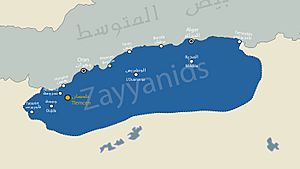Capture of Mers-el-Kébir (1505) facts for kids
Quick facts for kids Capture of Mers-el-Kébir |
|||||||||
|---|---|---|---|---|---|---|---|---|---|
| Part of the Spanish-Algerian war (1503–1512) | |||||||||
 The Zayyanid Kingdom around the time of the Spanish invasion |
|||||||||
|
|||||||||
| Belligerents | |||||||||
| Commanders and leaders | |||||||||
| Strength | |||||||||
| 7,000 soldiers 170 sailing vessels |
1,500 soldiers 30 horsemen |
||||||||
| Casualties and losses | |||||||||
| Unknown | Unknown | ||||||||
The Capture of Mers-el-Kébir happened on September 13, 1505. It was the first big step taken by the Spanish Empire in its war against the Kingdom of Tlemcen. This kingdom was located in what is now modern Algeria. Mers-el-Kébir (also known as Mazalquivir) was an important port city. It was a safe place for pirate ships and was protected by a strong castle. Before this, Portuguese forces had tried to capture it in 1496 and 1501 but failed.
Why Spain Attacked Mers-el-Kébir
After Spain finished its war to conquer Granada and stopped a rebellion there, some important people, like Cardinal Cisneros, thought Spain should take control of the North African coast. Their main reason was to stop pirate attacks on Spanish ships and towns. At this time, the Kingdom of Tlemcen was ruled by Abu Abdallah V. His kingdom was facing problems and was not very strong. This made it a good target for Spain.
Getting Ready for Battle
Spain put together a large fleet of 170 ships in the port of Málaga. These ships were meant to carry and supply 7,000 soldiers. The navy was led by Ramón de Cardona, and the ground troops were commanded by Diego Fernández de Córdoba. Their goal was to capture Mers-el-Kébir.
The fleet first left Malaga on August 20, 1505. But strong winds forced them to return to port. They tried again on September 3, but the same bad weather made them stop in Almería. Finally, on September 9, they managed to set sail. They arrived near Mers-el-Kébir on September 11.
The people of Algeria knew about the Spanish fleet because of spies. They had gathered their forces near Mers-el-Kébir. However, because of the Spanish delays due to weather, the Algerians thought the fleet was going somewhere else. So, they spread out their troops. This meant they were not fully ready when the Spanish finally arrived.
The Attack on the City
Three large Spanish ships, called carracks, led the attack. They were commanded by Basques named Juan de Lezcano and Flores de Marquina. To protect their ships, they covered the hulls with wool sacks. They sailed as close as possible to the castle and started firing their cannons. This made the castle's defenders fire back at them.
Meanwhile, the Spanish soldiers landed on the shore during a heavy rainstorm. They quickly moved to take control of the high ground near Mers-el-Kébir. From these higher positions, they could easily bombard the castle below and the ships in the port.
The next day, September 12, Algerian cavalry (soldiers on horseback) attacked the Spanish positions. But the Spanish soldiers fought them off. The defenders inside the castle then asked for a truce, or a temporary stop to the fighting, until September 13. They promised to surrender the castle if their king, Abu Abdallah V, did not send help by then.
The Spanish agreed to the truce. On September 13, no Algerian troops arrived to help the city. So, the people inside the castle, along with their families and belongings, left. The Spanish soldiers then moved in and took control of the castle. Soon after they had taken their positions, the Spanish saw a large Algerian army coming to help the city. But when the Algerian army saw that the city was already lost, they turned back and retreated to Oran.
Mers-el-Kébir fell on that day. Spain would control the city for nearly 300 years, with only a few interruptions. On September 24, the Spanish fleet sailed back to Malaga, leaving behind a group of 500 Spanish soldiers to guard the new castle.
See also
 In Spanish: Jornada de Mazalquivir para niños
In Spanish: Jornada de Mazalquivir para niños

